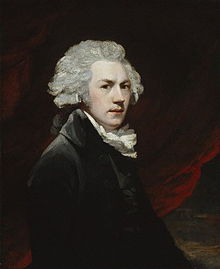Martin Archer Shee
Sir Martin Archer Shee | |
|---|---|
 Martin Archer shee, self-portrait, 1794 (National Portrait Gallery) | |
| Born | 23 December 1769 Dublin, Ireland |
| Died | 13 August 1850 (aged 81) Brighton, Sussex |
| Nationality | British |
| Known for | Portraiture |
Sir Martin Archer Shee PRA (23 December 1769 – 13 August 1850) was a British portrait painter and president of the Royal Academy.
Biography
He was born in Dublin, of an old Catholic Irish family, and his father Martin Shee, a merchant, regarded the profession of a painter as an unsuitable occupation for a descendant of the Shees. Martin Shee nevertheless studied art in the Royal Dublin Society and came to London. There, in 1788, he was introduced by Edmund Burke[1] to Joshua Reynolds, on whose advice he studied in the schools of the Royal Academy. In 1789 he exhibited his first two pictures, the "Head of an Old Man" and "Portrait of a Gentleman." Over the next ten years he steadily increased in practice. He was chosen an associate of the Royal Academy in 1798, in 1789 he married Mary, eldest daughter of James Power of Youghal, and in 1800 he was elected a Royal Academician. He moved to George Romney's former house in Cavendish Square, and set up as his successor.
Shee continued to paint with great readiness of hand and fertility of invention, although his portraits were eclipsed by more than one of his contemporaries, and especially by Thomas Lawrence. The earlier portraits of the artist are carefully finished, easy in action, with good drawing and excellent discrimination of character. They show an undue tendency to redness in the flesh painting—a defect which is still more apparent in his later works, 'in which the handling is less "square," crisp and forcible. In addition to his portraits he executed various subjects and historical works, such as Lavinia, Belisarius, his diploma picture "Prospero and Miranda", and the "Daughter of Jephthah."

In 1805 he published a poem consisting of Rhymes on Art, and a second part followed in 1809. Lord Byron spoke well of it in his English Bards and Scotch Reviewers. Shee published another small volume of verse in 1814, entitled The Commemoration of Sir Joshua Reynolds, and other Poems, but this was less successful. He also produced a tragedy, Alasco, set in Poland. The play was accepted at Covent Garden, but was refused a licence, on the grounds that it contained treasonable allusions, and Shee angrily resolved to make his appeal to the public. He carried out his threat in 1824, but Alasco was still on the list of unacted dramas in 1911. He also published two novels – "Oldcourt" (1829, in 3 volumes) and "Cecil Hyde" (1834).
On the death of Sir Thomas Lawrence in 1830, Shee was chosen president of the Royal Academy in his stead and shortly afterwards received a knighthood. In 1831 he was elected a Fellow of the Royal Society.[2] In an examination before the parliamentary committee of 1836 concerning the functions of the Royal Academy, he ably defended its rights. He continued to paint till 1845, when illness made him retire to Brighton. He was deputised for at the Academy by J. M. W. Turner, who had appointed him a trustee of the projected Turner almshouse.
From 1842–1849, he was the first president of the Birmingham Society of Artists.[3]
He died in Brighton in 1850 and was buried in the western extension to St Nicholas' Churchyard in Brighton. His headstone remains, but has been laid flat and moved to the perimeter of the site.[4]
Shee had three sons, who became successful barristers, and three daughters. Descendants of one of the sons was George Archer-Shee, whose story inspired The Winslow Boy, a play written by Terence Rattigan and his older half-brother Martin Archer-Shee MP. Shee's descendant Mary Archer-Shee supports the campaign for the fulfilment of Turner's wishes for his bequests.
Written works by Shee (selected)
- Elements of art, a poem; in six cantos (1809)
- Rhymes on Art; Or, The Remonstrance of a Painter: in Two Parts (1809)
- The Commemoration of Reynolds: In Two Parts (1814)
- Oldcourt: Volume 1, Volume 2, Volume 3 (London : H. Colburn, 1829)
- Alasco: A Tragedy, in Five Acts (Sherwood, Jones, and co., 1824).
Bibliography
- Martin Archer Shee, The Life of Sir Martin Archer Shee, Volume 1, Volume 2 (London: Longman, Green, Longman, and Roberts, 1860).
Notes
- ^ THE EUROPEAN MAGAZINE, AND LONDON REVIEW: ILLUSTRATIVE OF THE LITERATURE, HISTORY, BIOGEAPHY, POLITICS, ART, MANNERS, AND AMUSEMENTS OF THE AGE.
- ^ "Library and Archive catalogue". Royal Society. Retrieved 28 February 2012.
- ^ Anon (1933). "The Spring Exhibition, 1933 (catalogue)". RBSA.
{{cite journal}}: Cite journal requires|journal=(help) - ^ Dale, Antony (1991). Brighton Cemeteries. Brighton: Brighton Borough Council. p. 8.
References
- Chisholm, Hugh, ed. (1911). . Encyclopædia Britannica (11th ed.). Cambridge University Press.
External links
- Sir Martin Archer Shee online (ArtCyclopedia)
- Biography of M. A. Shee (Encyclopedia of Irish and World Art)
- William Archer Shee, the artist's son (Oil on canvas, Ca. 1820 – Metropolitan Museum of Art)
- 1769 births
- 1850 deaths
- People from County Dublin
- 18th-century Irish painters
- 19th-century Irish painters
- Irish portrait painters
- Royal Academicians
- Knights Bachelor
- Irish poets
- Irish novelists
- Irish dramatists and playwrights
- Male dramatists and playwrights
- Fellows of the Royal Society
- Members and Associates of the Royal Birmingham Society of Artists
- Irish male novelists
- Male poets
